
Skydiving is a thrilling and exhilarating activity that allows individuals to experience the ultimate freedom of flight. It’s an adventure that combines adrenaline, breathtaking views, and the rush of defying gravity. Whether you’re a seasoned skydiver or a curious onlooker, there’s no denying the awe-inspiring nature of this extreme sport. In this comprehensive article, we will explore the world of skydiving and uncover fascinating fun facts that will take your appreciation for this daring activity to new heights.
Ancient Inspiration
The idea of flying has fascinated humans for centuries. Ancient civilizations, such as the Chinese and the Greeks, expressed their dreams of flight through various myths and legends.
Leonardo da Vinci’s Influence
In the 15th century, the renowned artist and inventor Leonardo da Vinci made significant contributions to the concept of human flight. His sketches and designs laid the foundation for the modern understanding of aerodynamics.
The Parachute Invention
The invention of the parachute is attributed to Sebastien Lenormand, who made the first recorded successful parachute jump in 1783. This marked a significant milestone in the development of skydiving as we know it today.

The First Skydive
The history of skydiving can be traced back to the late 18th century when Andre-Jacques Garnerin made the first successful parachute descent in 1797. His daring feat paved the way for the development of modern skydiving.
Military Applications
Skydiving gained significant traction during World War II when it was used as a means for soldiers to safely exit aircraft. This marked a turning point in the evolution of skydiving, leading to advancements in equipment and techniques.
Terminal Velocity
Skydivers reach a state known as terminal velocity during freefall, where the force of gravity is balanced by the resistance of the air. This typically occurs at speeds of around 120 miles per hour (193 kilometers per hour).
Parachute Deployment
The deployment of a parachute is a critical moment in a skydive. Parachutes are designed to slow down the descent by increasing air resistance, allowing for a safe and controlled landing.
Aerodynamics and Body Positioning
Proper body positioning during freefall is essential for stability and control. Skydivers use techniques such as arching their bodies to maintain stability and minimize drag.
Tandem Skydiving
Tandem skydiving is an ideal choice for beginners as it involves jumping with a highly experienced instructor who controls the parachute. It allows individuals to experience the thrill of skydiving with minimal training.
Formation Skydiving
Formation skydiving involves groups of skydivers forming predetermined patterns or shapes while in freefall. It requires coordination, teamwork, and precise aerial maneuvers.
Freefly Skydiving
Freefly skydiving focuses on advanced body movements and acrobatics during freefall. Skydivers perform intricate maneuvers, flips, and spins while maintaining stability and control.
Training and Certification
Proper training and certification are essential for skydivers to develop the necessary skills and knowledge. It’s important to learn from qualified instructors and undergo thorough training programs.
Equipment Checks
Regular inspection and maintenance of skydiving equipment, including parachutes, harnesses, and altimeters, is vital to ensure their reliability and functionality.
Weather Conditions
Skydiving operations are highly dependent on weather conditions. It’s important to assess factors such as wind speed, visibility, and cloud cover to determine safe skydiving conditions.
Highest Altitude Skydive
Felix Baumgartner holds the record for the highest altitude skydive, jumping from a height of 128,100 feet (39,045 meters) in 2012. He achieved supersonic speeds during his descent.
Longest Freefall
Joseph Kittinger holds the record for the longest freefall, falling for a total of 4 minutes and 36 seconds during his historic jump from 102,800 feet (31,333 meters) in 1960.

Most Skydives in 24 Hours
Jay Stokes set the record for the most skydives in 24 hours, completing an astonishing 640 jumps in 1995.
Conclusion
Skydiving is an extraordinary adventure that offers an unparalleled rush of adrenaline and a profound sense of freedom. From its historical origins to the remarkable achievements of daring individuals, the world of skydiving is filled with excitement and awe-inspiring feats. So, whether you’re considering taking the leap or simply intrigued by the exhilarating world of skydiving, let this article serve as a glimpse into the captivating realm of airborne adrenaline.
Frequently Asked Questions (FAQs)
Is skydiving safe?
Skydiving, like any extreme sport, carries inherent risks. However, when proper safety precautions are followed, and participants receive adequate training, the risks can be minimized. It’s important to choose a reputable skydiving center and follow all instructions provided by experienced instructors.
Can anyone go skydiving?
Most healthy individuals who meet the age and weight requirements can go skydiving. However, certain medical conditions or physical limitations may restrict participation. It’s advisable to consult with a doctor and inform the skydiving center about any relevant health concerns before making a reservation.
How long does a skydive last?
The duration of a skydive can vary depending on factors such as exit altitude, freefall time, and canopy ride. On average, a skydive lasts around 5-7 minutes, with approximately 60 seconds of freefall before the parachute is deployed.
What should I wear for a skydive?
Comfortable clothing and appropriate footwear are recommended for a skydive. It’s best to wear athletic or sportswear that allows freedom of movement. Avoid loose-fitting clothes, jewelry, and accessories that may pose a risk during the jump.
Can I breathe during a skydive?
Yes, you can breathe normally during a skydive. Despite the high speeds and intense sensations, the airflow around you allows for unobstructed breathing. Experienced skydivers often describe the sensation of freefall as a rush of wind and exhilaration.
Was this page helpful?
Our commitment to delivering trustworthy and engaging content is at the heart of what we do. Each fact on our site is contributed by real users like you, bringing a wealth of diverse insights and information. To ensure the highest standards of accuracy and reliability, our dedicated editors meticulously review each submission. This process guarantees that the facts we share are not only fascinating but also credible. Trust in our commitment to quality and authenticity as you explore and learn with us.
